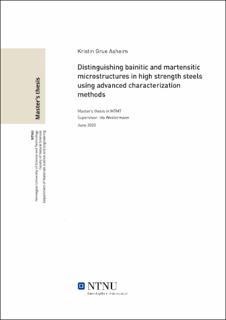| dc.contributor.advisor | Westermann, Ida | |
| dc.contributor.author | Asheim, Kristin Grue | |
| dc.date.accessioned | 2021-09-28T18:04:14Z | |
| dc.date.available | 2021-09-28T18:04:14Z | |
| dc.date.issued | 2020 | |
| dc.identifier | no.ntnu:inspera:59547306:17104236 | |
| dc.identifier.uri | https://hdl.handle.net/11250/2785264 | |
| dc.description.abstract | Gjennom dette arbeidet har to legeringer; 103Cr3/103C3 og 34CrNiMo6, blitt varmebehandlet
til perlittisk/ferritisk, bainittisk og martensittisk struktur for å bli studert i SEM. Å skille mellom bainittiske og martensittiske strukturer i SEM har vist seg å være meget vanskelig da de visuelt ser veldig like ut, og vanligvis blir prøvene studert i TEM for å helt sikkert kunne avgjøre hvilken av de to strukturene man har. Prøveprepareringen til TEM er tidkrevende og krever nøyaktighet og tolmodighet, og av den grunn har problemstillingen til denne masteroppgaven blitt å prøve ut en metode i SEM med bruk av EBSD og to ulike indekserisprogramvarer; TSL OIM Data Collection og EMsoft, for å skille martensitt fra bainitt.
Utfordringen med bruken av EBSD analyse er at de nevnte strukturene har relativt like gitterparametre,
og ved bruk av den kommersielle Hough-indekseringen som TSL bruker blir begge strukturene indeksert med ferritt. EMsoft, som bruker dictionary indexing, tok i bruk gitterparametrene og atomposisjonene til atomene i enhetscellen til hver enkelt fase for å simulere alle mulige EBSD-mønstre for et gitt spenningsintervall. De simulerte mønstrene ble dermed sammenlignet med de eksperimentelle mønstrene i hver pixel i EBSD-skannen for å finne den fasen som passet best.
Bainitt har en BCC-struktur med faste gitterparametre, mens martensitt har en BCT-struktur hvor gitterparametrene avhenger av karboninnholdet i legeringen. Med en legering med høyt karboninnhold (1.3 wt% i dette arbeidet) burde forskjellen mellom gitterparametrene til bainitt og martensitt i teorien blitt stor nok til at EMsoft skulle klare å skille de fra hverandre i indekseringen. En legering med lavere karboninnhold (0.36 wt%) ble inkludert i masterarbeidet for å se om martensitt og bainitt med denne sammensetningen også kunne skilles i EMsoft hvis det viste seg å fungere for den første legeringen.
Martensittprøvene av begge legeringene ble hardhetstestet og martensitt- og bainittprøvene av begge legeringene ble studert i TEM for å forsikre at begge strukturene var blitt produsert gjennom varmebehandlingen. TEM-analysen av bainittprøvene fant nåleformede karbider i strukturen, og slike karbider ble ikke funnet i martensittprøvene.
De to indekseringsprogrammene leverte lignende resulater når det gjalt å finne hvor de ulike
fasene befant seg i kartene av EBSD-skannen, noe som viste at EMsoft var en minst like troverdig
indekseringsprogramvare som TSL. Når EMsoft ble brukt til å indeksere bainitt- og martensittstrukturen med ferritt- og martensittfasen ble begge strukturene indeksert best med ferritt. Det samme resultatet kom fram fra begge legeringene og viste at metoden brukt med de oppnådde eksperimentelle dataene ikke kunne brukes til å skille bainitt fra martensitt i ved hjelp av EBSD i SEM. | |
| dc.description.abstract | In this work two steel alloys; 103Cr3/103C3 and 34CrNiMo6, were heat treated to pearlitic/ferritic,
bainitic and martensitic structures for scanning electron microscope (SEM) analysis. Differentiating bainitic and martensitic structures in SEM has shown to be very difficult for an untrained eye because of the visual similarities in the structures, and often transmission electron microscopy (TEM) is the best solution to ensure which structure you have. The sample preparation for TEM is time-consuming and expects great precision and patience from the user, and therefore the purpose of this work has been to try out a SEM analysis procedure using electron backscatter diffraction (EBSD), the indexing software TSL OIM Data Collection for Hough
indexing and EMsoft for dictionary indexing to differentiate bainite from martensite.
The challenge with EBSD analysis for the structures mentioned was that the difference in lattice parameters in bainite and martensite were small, and the phases were both indexed as ferrite using the traditional Hough indexing. With EMsoft the dictionary indexing was applied to the EBSD scans to index the possible phases present in the sample. Through EMsoft lattice parameters and atom positions for each phase were used to simulate all possible EBSD patterns for a given voltage range. These simulated patterns were then matched with the experimental patterns obtained in an EBSD scan to find the phase that fitted best.
While bainite has a body centered cubic structure with fixed lattice parameters, the lattice parameters
of the martensite structure are dependent on the carbon content in the alloy. With an alloy containing a great amount of carbon (1.3 wt%), the differences in the lattice of bainite and martensite would in theory be big enough for EMsoft to index them separately and not confuse them with each other. The alloy with less carbon (0.36 wt%) was included in the work to see if the technique also worked for an alloy with lower carbon content if it showed to work for the high-carbon steel.
The martensite samples of both alloys were hardness tested and the martensite and bainite samples
of both alloys were analyzed in TEM to ensure that the two structures were obtained. In the bainite samples tiny needle-formed carbides were found in the structure. No carbides were found in the TEM analysis of the martensite structures.
The two indexing softwares both gave similar results when indexing phases in the EBSD scans, showing the new EMsoft software to be just as good and reliable as the conventional TSL software. When EMsoft was used to index the bainite and martensite structure with ferrite and martensite phase, both the bainitic and martensitic structure was best indexed as ferrite. This was the result for both alloys, and showed that the procedure used on the experimental data obtained through this work was not able to differentiate bainite from martensite using EBSD in SEM. | |
| dc.language | | |
| dc.publisher | NTNU | |
| dc.title | Distinguishing bainitic and martensitic microstructures in high strength steels using advanced characterization methods | |
| dc.type | Master thesis | |
